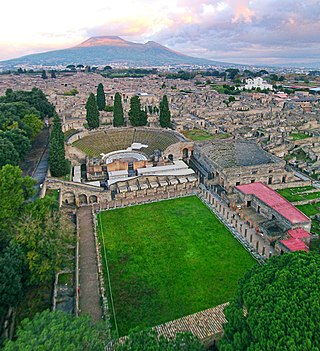Finds
- 1738: First formal excavations of Herculaneum, by Roque Joaquín de Alcubierre sponsored by Charles III of Spain [1]

| 1720s .1730s in archaeology. 1740s |
| Other topics: N/A |
| |||
|---|---|---|---|
| +... | |||
The decade of the 1730s in archaeology involved some significant events.


The three-age system is the periodization of human prehistory into three time-periods: the Stone Age, the Bronze Age, and the Iron Age, although the concept may also refer to other tripartite divisions of historic time periods. In some periodizations, a fourth Copper Age is added as between the Stone Age and Bronze Age. The Copper, Bronze, and Iron Ages are also known collectively as the Metal Ages.

Prehistoric archaeology is a subfield of archaeology, which deals specifically with artefacts, civilisations and other materials from societies that existed before any form of writing system or historical record. Often the field focuses on ages such as the Stone Age, Bronze Age and Iron Age, although it also encompasses periods such as the Neolithic. The study of prehistoric archaeology reflects the cultural concerns of modern society by showing interpretations of time between economic growth and political stability. It is related to other disciplines such as geology, biology, anthropology, historiography and palaeontology, although there are noticeable differences between the subjects they all broadly study to understand; the past, either organic or inorganic or the lives of humans. Prehistoric archaeology is also sometimes termed as anthropological archaeology because of its indirect traces with complex patterns.

Luigi Antonio Lanzi was an Italian Jesuit priest, known for his writings as an art historian and archaeologist. When he died he was buried in the church of the Santa Croce at Florence by the side of Michelangelo.

The Villa of the Papyri was an ancient Roman villa in Herculaneum, in what is now Ercolano, southern Italy. It is named after its unique library of papyri scrolls, discovered in 1750. The Villa was considered to be one of the most luxurious houses in all of Herculaneum and in the Roman world. Its luxury is shown by its exquisite architecture and by the large number of outstanding works of art discovered, including frescoes, bronzes and marble sculpture which constitute the largest collection of Greek and Roman sculptures ever discovered in a single context.
Archaeology is the study of human activity in the past, primarily through the recovery and analysis of the material culture and environmental data that they have left behind, which includes artifacts, architecture, biofacts and cultural landscapes.
William Greenwell, was an English archaeologist and Church of England priest.
The year 1810 in archaeology involved some significant events.
Below are notable events in archaeology that occurred in 1894.
Below are notable events in archaeology that occurred in 1936.

Pompeii and Herculaneum were once thriving towns, 2,000 years ago, in the Bay of Naples. Both cities have rich histories influenced by Greeks, Oscans, Etruscans, Samnites and finally the Romans. They are most renowned for their destruction: both were buried in the AD 79 eruption of Mount Vesuvius. For over 1,500 years, these cities were left in remarkable states of preservation underneath volcanic ash, mud and rubble. The eruption obliterated the towns but in doing so, was the cause of their longevity and survival over the centuries.
The decade of the 1690s in archaeology involved some significant events.
The decade of the 1750s in archaeology involved some significant events.
The decade of the 1770s in archaeology involved some significant events.
The decade of the 1780s in archaeology involved some significant events.
The decade of the 1790s in archaeology involved some significant events.

Archaeology or archeology is the study of human activity through the recovery and analysis of material culture. The archaeological record consists of artifacts, architecture, biofacts or ecofacts, sites, and cultural landscapes. Archaeology can be considered both a social science and a branch of the humanities. It is usually considered an independent academic discipline, but may also be classified as part of anthropology, history or geography. The discipline involves surveying, excavation, and eventually analysis of data collected, to learn more about the past. In broad scope, archaeology relies on cross-disciplinary research.

Pompeii was a city in what is now the municipality of Pompei, near Naples, in the Campania region of Italy. Along with Herculaneum, Stabiae, and many surrounding villas, the city was buried under 4 to 6 m of volcanic ash and pumice in the eruption of Mount Vesuvius in 79 AD.

Herculaneum is an ancient Roman town located in the modern-day comune of Ercolano, Campania, Italy. Herculaneum was buried under a massive pyroclastic flow in the eruption of Mount Vesuvius in 79 AD.
Cecily Margaret Guido,, also known as Peggy Piggott, was an English archaeologist, prehistorian, and finds specialist. Her career in British archaeology spanned sixty years, and she is recognised for her field methods, her field-leading research into prehistoric settlements, burial traditions, and artefact studies, as well as her high-quality and rapid publication, contributing more than 50 articles and books to her field between the 1930s and 1990s.